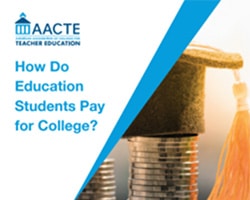
How Do Education Students Pay for College?
There is a growing body of research suggesting that concerns about compensation generally—and about being able to repay student loans in particular—are dissuading college students from choosing teaching as a career. To help AACTE members better understand the financial pressures impacting education students, a new issue brief takes a detailed look at how students pursuing a bachelor’s degree in education pay for college, including the costs that they face and the financial sources that they tap to meet those expenses. The brief’s author, Dr. Jacqueline King, will review these important findings. She will be joined by Dr. Jane West for a discussion of the implications of these findings for campus practice and federal policy. Dr. West will share AACTE’s priorities for strengthening aid to future educators in federal appropriations bills as well as the reauthorization of the Higher Education Act. The webinar will feature time for questions and discussion.
Jacqueline E. King, Ph.D.
Jacqueline King is an independent consultant who works with K-12 and higher education leaders to improve student outcomes. She has had a long career in education, including 15 years at the American Council on Education (ACE) where she established the ACE Center for Policy Analysis. Dr. King is the author or co-author of numerous reports, articles, and book chapters on college readiness, student financing of higher education, access and persistence in postsecondary education, student demographic trends, and trends in the leadership of higher education. Her work has been featured on CNN and in national publications such as The New York Times, Time, USA Today, and the Washington Post.
Dr. King holds a BA from the University of California, Berkeley, an MA from Teachers College, Columbia, and Ph.D. in higher education from the University of Maryland, College Park.
Jane E. West, Ph.D.
A former teacher and education administrator, Dr. Jane West is visiting professor at the University of Maryland and adjunct faculty at Virginia Commonwealth University. She serves as policy advisor to several national education organizations, including the American Association of Colleges for Teacher Education (http://aacte.org/), the Higher Education Consortium for Special Education (http://www.hecse.net/) and the Teacher Education Division of the Council for Exceptional Children (http://www.tedcec.org/). For 8 years she led AACTE’s advocacy and policy work as Senior Vice President. In the mid 1980’s she worked as senior education advisor on the United States Senate Committee on Health, Education, Labor and Pensions where she led the national effort to craft multiple federal education statutes.
West holds a BA from the University of California at Santa Barbara, an MA from Teachers College, Columbia University and a Ph.D. in special education from the University of Maryland.
